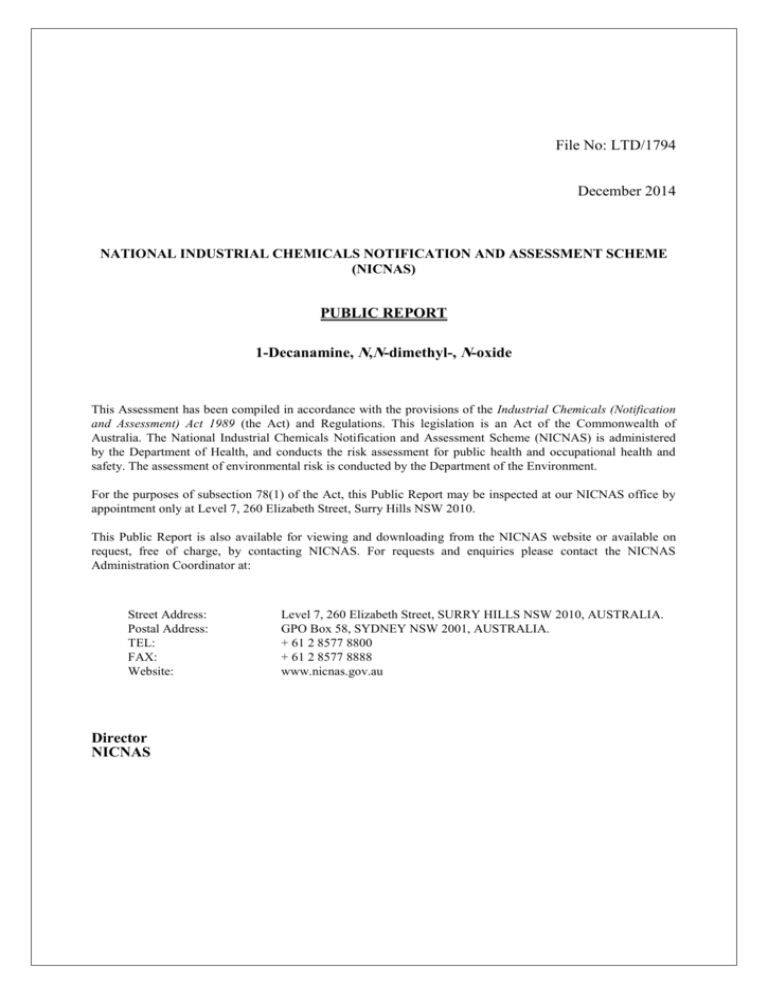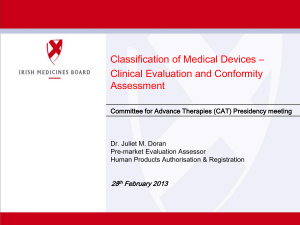LTD/1794
advertisement

File No: LTD/1794 December 2014 NATIONAL INDUSTRIAL CHEMICALS NOTIFICATION AND ASSESSMENT SCHEME (NICNAS) PUBLIC REPORT 1-Decanamine, N,N-dimethyl-, N-oxide This Assessment has been compiled in accordance with the provisions of the Industrial Chemicals (Notification and Assessment) Act 1989 (the Act) and Regulations. This legislation is an Act of the Commonwealth of Australia. The National Industrial Chemicals Notification and Assessment Scheme (NICNAS) is administered by the Department of Health, and conducts the risk assessment for public health and occupational health and safety. The assessment of environmental risk is conducted by the Department of the Environment. For the purposes of subsection 78(1) of the Act, this Public Report may be inspected at our NICNAS office by appointment only at Level 7, 260 Elizabeth Street, Surry Hills NSW 2010. This Public Report is also available for viewing and downloading from the NICNAS website or available on request, free of charge, by contacting NICNAS. For requests and enquiries please contact the NICNAS Administration Coordinator at: Street Address: Postal Address: TEL: FAX: Website: Director NICNAS Level 7, 260 Elizabeth Street, SURRY HILLS NSW 2010, AUSTRALIA. GPO Box 58, SYDNEY NSW 2001, AUSTRALIA. + 61 2 8577 8800 + 61 2 8577 8888 www.nicnas.gov.au TABLE OF CONTENTS SUMMARY ............................................................................................................................................................ 3 CONCLUSIONS AND REGULATORY OBLIGATIONS ................................................................................... 3 ASSESSMENT DETAILS ..................................................................................................................................... 5 1. APPLICANT AND NOTIFICATION DETAILS .................................................................................... 5 2. IDENTITY OF CHEMICAL .................................................................................................................... 5 3. COMPOSITION ....................................................................................................................................... 5 4. PHYSICAL AND CHEMICAL PROPERTIES ....................................................................................... 6 5. INTRODUCTION AND USE INFORMATION ..................................................................................... 6 6. HUMAN HEALTH IMPLICATIONS ..................................................................................................... 7 6.1. Exposure Assessment ...................................................................................................................... 7 6.1.1. Occupational Exposure ............................................................................................................... 7 6.1.2. Public Exposure .......................................................................................................................... 7 6.2. Human Health Effects Assessment ................................................................................................. 7 6.3. Human Health Risk Characterisation .............................................................................................. 8 6.3.1. Occupational Health and Safety ................................................................................................. 8 6.3.2. Public Health .............................................................................................................................. 8 7. ENVIRONMENTAL IMPLICATIONS ................................................................................................... 8 7.1. Environmental Exposure & Fate Assessment ................................................................................. 8 7.1.1. Environmental Exposure ............................................................................................................ 8 7.1.2. Environmental Fate .................................................................................................................... 8 7.1.3. Predicted Environmental Concentration (PEC) .......................................................................... 8 7.2. Environmental Effects Assessment ................................................................................................. 9 7.2.1. Predicted No-Effect Concentration ............................................................................................ 9 BIBLIOGRAPHY ................................................................................................................................................. 11 December 2014 NICNAS SUMMARY The following details will be published in the NICNAS Chemical Gazette: ASSESSMENT APPLICANT(S) REFERENCE LTD/1794 Bralson Pty Ltd (trading as MotorActive) CHEMICAL OR HAZARDOUS INTRODUCTION TRADE NAME CHEMICAL VOLUME 1-Decanamine, N,N-dimethyl-, Noxide ND* ≤ 0.31 tonnes per annum USE Component of automotive wheel cleaner *ND = not determined CONCLUSIONS AND REGULATORY OBLIGATIONS Hazard classification As no toxicity data were provided, the notified chemical cannot be classified according to the Globally Harmonised System for the Classification and Labelling of Chemicals (GHS), as adopted for industrial chemicals in Australia, or the Approved Criteria for Classifying Hazardous Substances (NOHSC, 2004). Human health risk assessment Under the conditions of the occupational settings described, the notified chemical is not considered to pose an unreasonable risk to the health of workers. When used in the proposed manner, the notified chemical is not considered to pose an unreasonable risk to public health. Environmental risk assessment On the basis of the PEC/PNEC ratio and the reported use pattern, the notified chemical is not considered to pose an unreasonable risk to the environment. Recommendations CONTROL MEASURES Occupational Health and Safety A person conducting a business or undertaking at a workplace should implement the following safe work practices to minimise occupational exposure during handling of the notified chemical as introduced: Avoid eye contact Guidance in selection of personal protective equipment can be obtained from Australian, Australian/New Zealand or other approved standards. A copy of the (M)SDS should be easily accessible to employees. If products and mixtures containing the notified chemical are classified as hazardous to health in accordance with the Globally Harmonised System for the Classification and Labelling of Chemicals (GHS) as adopted for industrial chemicals in Australia, workplace practices and control procedures consistent with provisions of State and Territory hazardous substances legislation should be in operation. PUBLIC REPORT: LTD/1794 Page 3 of 11 December 2014 NICNAS Disposal Where reuse or recycling are not appropriate, dispose of the notified chemical in an environmentally sound manner in accordance with relevant Commonwealth, state, territory and local government legislation. Emergency procedures Spills or accidental release of the notified chemical should be handled by physical containment, collection and subsequent safe removal. Regulatory Obligations Secondary Notification This risk assessment is based on the information available at the time of notification. The Director may call for the reassessment of the chemical under secondary notification provisions based on changes in certain circumstances. Under Section 64 of the Industrial Chemicals (Notification and Assessment) Act (1989) the notifier, as well as any other importer or manufacturer of the notified chemical, have post-assessment regulatory obligations to notify NICNAS when any of these circumstances change. These obligations apply even when the notified chemical is listed on the Australian Inventory of Chemical Substances (AICS). Therefore, the Director of NICNAS must be notified in writing within 28 days by the notifier, other importer or manufacturer: (1) Under Section 64(1) of the Act; if the importation volume exceeds one tonne per annum notified chemical; or (2) Under Section 64(2) of the Act; if the function or use of the chemical has changed from component of automotive wheel cleaner, or is likely to change significantly; the amount of chemical being introduced has increased, or is likely to increase, significantly; the chemical has begun to be manufactured in Australia; additional information has become available to the person as to an adverse effect of the chemical on occupational health and safety, public health, or the environment. The Director will then decide whether a reassessment (i.e. a secondary notification and assessment) is required. (Material) Safety Data Sheet The (M)SDS of the product containing the notified chemical provided by the notifier was reviewed by NICNAS. The accuracy of the information on the (M)SDS remains the responsibility of the applicant. PUBLIC REPORT: LTD/1794 Page 4 of 11 December 2014 NICNAS ASSESSMENT DETAILS 1. APPLICANT AND NOTIFICATION DETAILS APPLICANT(S) Bralson Pty Ltd trading as MotorActive (ABN: 15 050 094 650) Unit 35, Slough Business Park Holker Street Silverwater NSW 2128 NOTIFICATION CATEGORY Limited-small volume: Chemical other than polymer (1 tonne or less per year). EXEMPT INFORMATION (SECTION 75 OF THE ACT) No details are claimed exempt from publication. VARIATION OF DATA REQUIREMENTS (SECTION 24 OF THE ACT) Variation to the schedule of data requirements is claimed for all physico-chemical endpoints PREVIOUS NOTIFICATION IN AUSTRALIA BY APPLICANT(S) None NOTIFICATION IN OTHER COUNTRIES None 2. IDENTITY OF CHEMICAL MARKETING NAME(S) G9524 Hot Rims Factory Equipped Wheel Cleaner (imported product containing the notified chemical at 1.5% concentration) CAS NUMBER 2605-79-0 CHEMICAL NAME 1-Decanamine, N,N-dimethyl-, N-oxide OTHER NAME(S) Decylamine oxide MOLECULAR FORMULA C12H27NO STRUCTURAL FORMULA MOLECULAR WEIGHT 201.35 Da 3. COMPOSITION DEGREE OF PURITY > 95% PUBLIC REPORT: LTD/1794 Page 5 of 11 December 2014 NICNAS HAZARDOUS IMPURITIES/RESIDUAL MONOMERS None NON HAZARDOUS IMPURITIES/RESIDUAL MONOMERS (> 1% BY WEIGHT) None ADDITIVES/ADJUVANTS None 4. PHYSICAL AND CHEMICAL PROPERTIES APPEARANCE AT 20 ºC AND 101.3 kPa: White powder Property Melting Point/Freezing Point Value 152.6 °C Data Source/Justification Calculated (MPBVP v1.43; US EPA, 2011) Boiling Point 403.41 °C Calculated (MPBVP v1.43; US EPA, 2011) Density* 1,020-1,030 kg/m3 MSDS Vapour Pressure 4.58 x 10-8 kPa at 25 °C Calculated (MPBVP v1.43; US EPA, 2011) Water Solubility 3.0 x 10-4 g/L Calculated using WSKOW v1.41 (US EPA, 2009) Hydrolysis as a Function of Not determined The notified chemical contains pH hydrolysable functionalities. It is expected to hydrolyse under environmental conditions (pH 4–9) Partition Coefficient log Pow = 3.69 Calculated using KOWWIN v1.67 (US (n-octanol/water) EPA, 2009) Adsorption/Desorption log Koc = 2.9 Calculated using KOCWIN v2.00 (US EPA, 2009) Dissociation Constant Not determined The notified chemical is a salt and will dissociate in water Flash Point* > 93 °C MSDS Autoignition Temperature Not determined Not expected to autoignite Explosive Properties Not determined Not expected to be explosive based on structure Oxidising Properties Not determined Not expected to be oxidising based on structure * For imported product containing the notified chemical at 1.5% concentration DISCUSSION OF PROPERTIES Reactivity The notified chemical is expected to be stable under normal conditions of use. Physical hazard classification Based on the submitted physico-chemical data depicted in the above table, the notified chemical is not recommended for hazard classification according to the Globally Harmonised System for the Classification and Labelling of Chemicals (GHS), as adopted for industrial chemicals in Australia. 5. INTRODUCTION AND USE INFORMATION MODE OF INTRODUCTION OF NOTIFIED CHEMICAL (100%) OVER NEXT 5 YEARS The notified chemical will be imported into Australia as a component of an end-use automotive wheel cleaning product at 1.5% concentration. PUBLIC REPORT: LTD/1794 Page 6 of 11 December 2014 NICNAS MAXIMUM INTRODUCTION VOLUME OF NOTIFIED CHEMICAL (100%) OVER NEXT 5 YEARS Year Tonnes 1 0.25 2 0.27 3 0.28 4 0.29 5 0.31 PORT OF ENTRY Sydney IDENTITY OF RECIPIENTS Bralson Pty ltd (trading as MotorActive) TRANSPORTATION AND PACKAGING The notified chemical will be imported in the automotive cleaning product (at a concentration of 1.5%) by sea freight, packaged within 710 mL plastic spray bottles and transported by road within Australia. USE The notified chemical will be used as a component of an automotive wheel cleaning product at 1.5% concentration. OPERATION DESCRIPTION The notified chemical will not be manufactured in Australia. No reformulation or repackaging of the automotive wheel cleaning product containing the notified chemical at a concentration of 1.5% will occur. The automotive wheel cleaning product containing the notified chemical at 1.5% concentration will be applied to car wheels by hand spray. After ~15 seconds the cleaning product will be removed by rinsing with water and the tyre may then be dried with a chamois. 6. 6.1. HUMAN HEALTH IMPLICATIONS Exposure Assessment 6.1.1. Occupational Exposure Exposure to workers during transport and storage of the imported automotive wheel cleaning product containing the notified chemical at 1.5% concentration is not expected except in the unlikely event of an accident. The automotive wheel cleaning product containing the notified chemical at 1.5% concentration may be used in occupational settings. PPE may be used by workers to minimise exposure. If PPE is used, worker exposure to the notified chemical at 1.5% concentration is expected to be of a similar or lesser extent than that experienced by consumers using the wheel cleaning product containing the notified chemical. 6.1.2. Public Exposure The public may be exposed to the notified chemical at a concentration of 1.5% when applying the automotive wheel cleaner product. The main route of exposure is expected to be dermal although ocular exposure may also occur. Inhalation exposure is expected to be limited given the low vapour pressure of the notified chemical and the method of application is not expected to generate droplets of inhalable size. The safety directions on the product label indicate that users should wear eye protection and gloves when using given the corrosive nature of the product. Where worn the potential for exposure will be limited. 6.2. Human Health Effects Assessment No toxicity data were submitted. The notified chemical is ionic and highly water soluble therefore dermal absorption may be limited. Absorption across the gastrointestinal tract is expected to occur. The notified chemical is a surfactant and therefore may have the potential to be irritating. Indeed the notified chemical has been classified on ECHA’s Classification and Labelling Inventory as a Category 2 skin irritant (H315: Causes skin irritation) and a Category 1 eye irritant (H318: Causes serious eye irritation) . PUBLIC REPORT: LTD/1794 Page 7 of 11 December 2014 NICNAS Health hazard classification As no toxicity data were provided, the notified chemical cannot be classified according to the Globally Harmonised System for the Classification and Labelling of Chemicals (GHS), as adopted for industrial chemicals in Australia, or the Approved Criteria for Classifying Hazardous Substances (NOHSC, 2004). 6.3. Human Health Risk Characterisation 6.3.1. Occupational Health and Safety The notified chemical may have the potential to be irritating to the skin and severely irritating to the eye. Based on its physico-chemical properties, the notified chemical is likely to have limited potential for dermal absorption; hence systemic toxicity by the dermal route is expected to be limited. Workers may be exposed to the notified chemical at 1.5% concentration as a result of accidental release or when using the wheel cleaning product containing the notified chemical. At this proposed use concentration the notified chemical is only expected to present at most as a slight eye irritant. Therefore, based on the low use concentration, the risk to workers from use of the notified chemical is not considered to be unreasonable. 6.3.2. Public Health The public may be exposed to the notified chemical at 1.5% concentration during use of the wheel cleaning product containing the notified chemical. At this proposed use concentration the notified chemical is only expected to present at most as a slight eye irritant. Therefore, based on the low use concentration, the risk to the public from use of the notified chemical is not considered to be unreasonable. 7. ENVIRONMENTAL IMPLICATIONS 7.1. Environmental Exposure & Fate Assessment 7.1.1. Environmental Exposure RELEASE OF CHEMICAL AT SITE The notified chemical will be imported as the finished product. It will not be manufactured in Australia. Any notified chemical that is released during transport is assumed to be contained and disposed of according to local regulations. RELEASE OF CHEMICAL FROM USE The product containing the notified chemical will be used for factory equipped wheel cleaning. Therefore, the majority of the notified chemical is expected to be released to sewer as the result of disposal of used water in cleaning wheels. RELEASE OF CHEMICAL FROM DISPOSAL The notified chemical contained in product residues remaining in empty containers is expected to be disposed of to landfill. 7.1.2. Environmental Fate The majority of the notified chemical is expected to be released to sewer at the end of its useful life. During waste water treatment processes in sewage treatment plant (STP), a large proportion of the notified chemical is expected to be removed from waste waters via degradation or by sorption to sludge based on its cationic properties. The sludge is expected to be disposed of to landfill or applied to agricultural soils. A proportion of the notified chemical may remain in the water column in STP effluent and be released to the aquatic compartment. Based on its expected water solubility the notified chemical is not expected to bioaccumulate in aquatic organisms. In water and landfill, the notified chemical is expected to degrade by biotic and abiotic processes to form water, oxides of carbon and nitrogen. 7.1.3. Predicted Environmental Concentration (PEC) The calculation for the predicted environmental concentration (PEC) is summarised in the table below assuming that 100% of the notified chemical will be released to sewer on a nationwide basis over 365 days per year. It is also assumed, under a worst-case scenario, that there is no removal of the notified chemical during STP processes. PUBLIC REPORT: LTD/1794 Page 8 of 11 December 2014 NICNAS Predicted Environmental Concentration (PEC) for the Aquatic Compartment Total Annual Import/Manufactured Volume Proportion expected to be released to sewer Annual quantity of chemical released to sewer Days per year where release occurs Daily chemical release: Water use Population of Australia (Millions) Removal within STP Daily effluent production: Dilution Factor - River Dilution Factor - Ocean PEC - River: PEC - Ocean: 310 100% 310 365 0.85 200.0 22.613 0% 4,523 1.0 10.0 0.19 0.02 kg/year kg/year days/year kg/day L/person/day million ML μg/L μg/L STP effluent re-use for irrigation occurs throughout Australia. The agricultural irrigation application rate is assumed to be 1000 L/m2/year (10 ML/ha/year). The notified chemical in this volume is assumed to infiltrate and accumulate in the top 10 cm of soil (density 1500 kg/m 3). Using these assumptions, irrigation with a concentration of 0.188 µg/L may potentially result in a soil concentration of approximately 0.0012 mg/kg. Assuming accumulation of the notified chemical in soil for 5 and 10 years under repeated irrigation, the concentration of notified chemical in the applied soil in 5 and 10 years may be approximately 0.006 mg/kg and 0.012 mg/kg, respectively. 7.2. Environmental Effects Assessment No ecotoxicity data were submitted. As there is the potential for high aquatic exposure from the use and disposal of the notified chemical, modelled estimates for ecotoxicological endpoints for the notified chemical were calculated using (ECOSAR (v4.00), using the class specific for the functional groups the notified chemical contains and the user entered log Kow = 3.61. The endpoints are tabulated below. Endpoint Acute Toxicity Fish (96 h) Daphnia (48 h) Algal (96 h) Result Assessment Conclusion LC50 = 2.99 mg/L EC50 = 0.43 mg/L EC50 = 0.24 mg/L Toxic -harmful to fish Very toxic to aquatic invertebrates Very toxic to algae The modelled endpoints used here were derived from the ECOSAR, using a class that was the best fit for the notified chemical, and are considered useful to provide a general indication of potential environmental effects for the notified chemical. However, the number of chemicals in the training set used to develop the ECOSAR class is considered to be insufficient to confidently classify the notified chemical. Therefore, these modelled endpoints are not considered sufficient to formally classify the acute hazard of the notified chemical under the Globally Harmonised System for the Classification and Labelling of Chemicals (United Nations, 2009). 7.2.1. Predicted No-Effect Concentration The predicted no-effect concentration (PNEC) has been calculated from the estimated acute algae toxicity of the notified chemical and an assessment factor of 500. A more conservative assessment factor of 500 is appropriate, in this case, as although acute endpoints for three trophic levels are available as a general indication of potential toxicity, these endpoints are modelled estimates from a classed-based model which has a low number of chemicals in the training sets. Predicted No-Effect Concentration (PNEC) for the Aquatic Compartment ErC50 Assessment Factor PNEC: PUBLIC REPORT: LTD/1794 0.24 500 0.86 mg/L µg/L Page 9 of 11 December 2014 NICNAS Environmental Risk Assessment Risk Assessment Q - River Q - Ocean PEC μg/L 0.19 0.019 PNEC μg/L 0.86 0.86 Q 0.22 0.02 The risk quotient for discharge of the notified chemical to the aquatic environment indicates that the notified chemical is unlikely to reach ecotoxicologically significant concentrations based on its annual importation quantity. The notified chemical is calculated to be biodegradable and due to its calculated moderate solubility in water is expected to have a low potential for bioaccumulation. On the basis of the PEC/PNEC ratio, low import volume and assessed use pattern, the notified chemical is not expected to pose an unreasonable risk to the aquatic environment. PUBLIC REPORT: LTD/1794 Page 10 of 11 December 2014 NICNAS BIBLIOGRAPHY NOHSC (2004) Approved Criteria for Classifying Hazardous Substances, 3rd edition [NOHSC:1008(2004)]. National Occupational Health and Safety Commission, Canberra, AusInfo. SWA (2012) Code of Practice: Managing Risks of Hazardous Chemicals in the Workplace, Safe Work Australia, http://www.safeworkaustralia.gov.au/sites/swa/about/publications/pages/managing-risks-of-hazardouschemicals-in-the-workplace. United Nations (2009) Globally Harmonised System of Classification and Labelling of Chemicals (GHS), 3rd revised edition. United Nations Economic Commission for Europe (UN/ECE), <http://www.unece.org/trans/danger/publi/ghs/ghs_rev03/03files_e.html >. US EPA (2009) Estimations Programs Interface Suite™ for Microsoft® Windows, v 4.00. United States Environmental Protection Agency. Washington, DC, USA. Accessed on 9 September 2014. US EPA (2012) Ecological Structure Activity Relationship toxicological Structural activity v1.11.United States Environmental Protection Agency. Washington, DC, USA. Accessed on 9 September 2014. PUBLIC REPORT: LTD/1794 Page 11 of 11




